How Big Can a Black Ghost Knife Fish Get
If you're reading this, you are probably considering adding a Black Ghost Knife Fish to your aquarium and let me tell you, I can't blame you! They are mesmerizing, elegant, and truly something unique. A special species of fish that are a delight to own.
Species Profile
A member of the speckled knife Fish group, the Black Ghost is popular amongst aquarists. A true bony fish with a body that, yes you guessed it, resembles a knife.
However, this is not their only distinctive feature. They have several others, including a weak electrical organ used mainly for navigation and to locate food.
A generally nocturnal fish, the Black Ghost is naturally timid. Nevertheless, with patience, you can coax it into being a far more friendly fish than some give it credit for being. However, they are not the easiest species to keep happy, healthy, and cared for, and will need excellent upkeep.
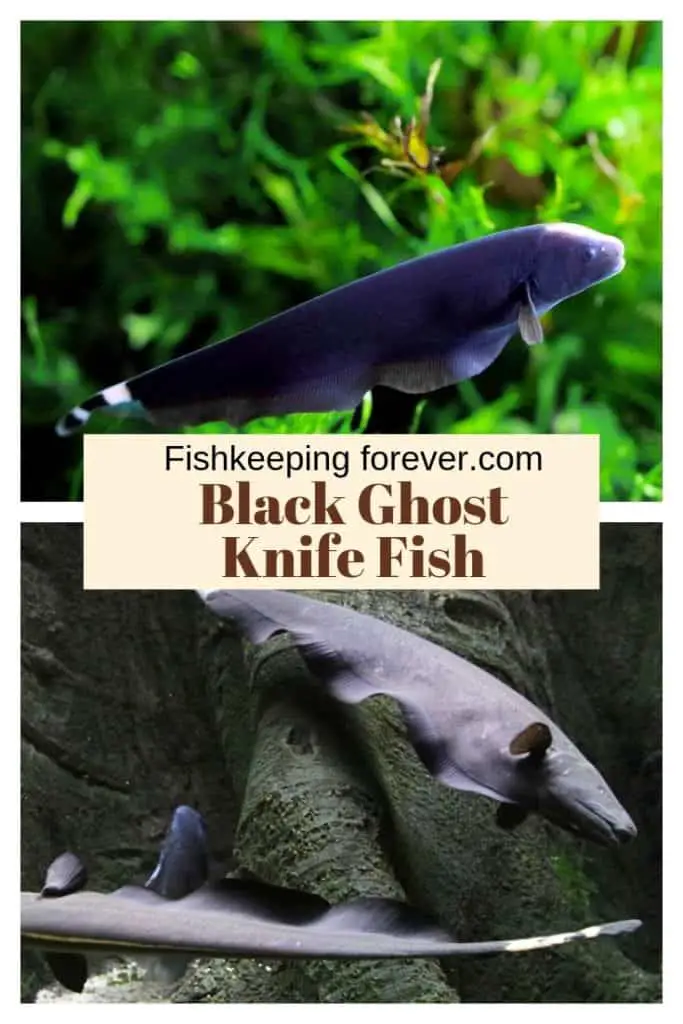
Wondering what Black Ghost Knife Fish Eat?
Click here ? to find out what we feed our 8″ Ghost Knife Fish and read customer reviews on the product.
Black Ghost Knife Fish Data
| Scientific Name | Apteronotus Albifrons |
|---|---|
| Common Names | Black Knife, Apteronotid Eel |
| Family | Apteronotidae |
| Origin | South America, Amazon Basin |
| Lifespan | 10-16 Years in captivity |
| Sociability | Semi-aggressive |
| Growth | 50 cm 16" Max in the wild. In captivity 14" |
| Diet | Technically they are Omnivores but they prefer animal matter. |
| Tank Level | Lower Level swimmers |
| Care Level | Moderate-Experienced |
| Breeding | Egg Layer-Little is known about breeding in a home aquarium |
| Cost | Small $4 Medium $12 Adult $40+ |
| Community Fish | No-Will nip smaller fish and grow too large |
| Fishkeeping Rating | 4 out of 5 stars. Unique fish but limited appeal due to size |
Classification:
Class: Actinopterigii
Order: Cypriniformes
Family: Apteronotidae
Genus:Apteronotus
Species:A. albifrons
Synonyms
Apteronotus passan Lacepède, 1800
Gymnotus albifrons Linnaeus, 1766
Sternarchus-albifrons (Linnaeus, 1766)
Sternarchus-lacepedii Castelnau, 1855
Sternarchus-maximilliani Castelnau, 1855
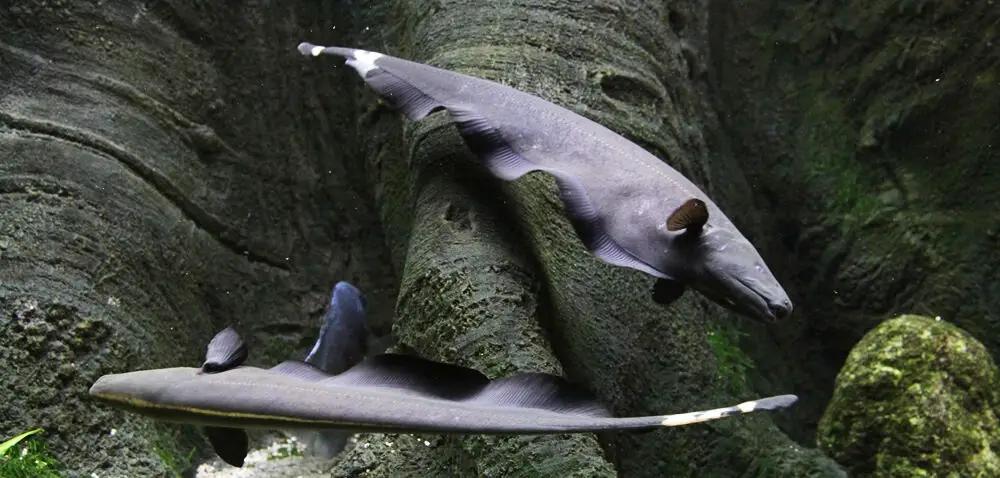
Color And Appearance
The Black Ghost Knife Fish has an elongated body capable of reaching up to around 18 inches in length and 3 inches in width. They also have a flat abdomen, large head, a mouth that opens incredibly wide, and thins off towards their tails.
They have no abdominal or dorsal fin, just an anal fin that goes from head to tail. This fin undulates in a waving motion and makes them capable of swimming in any direction.
A scaleless fish, the Black Ghost is entirely jet black except for two white rings towards the end of its tail. In addition, they have a white blaze on the nose. Occasionally, but not often, this white blaze may extend into a white stripe that will run down the back.
They are incredibly attractive in both appearance and movement making them quite the showpiece.
Natural habitat of the Black Ghost Knife Fish
A South American freshwater fish, the Black Ghost can be found from Venezuela to the Paraguay-Parana river, including the Amazon Basin.
You will usually find them in the moderate moving waters of sandy-bottomed creeks. They are known to migrate to flooded forests during the mating season. They prefer black waters with lots of tannings from fallen leaves, but never brackish.
Fun Fact: You can train Black Ghost Knife Fish to eat from your hand and they often sense when you're near the aquarium.
In their natural habitat, the Black Ghost is rarely seen, although some are caught and exported into the fish trade. However, most are farmed in large pools in Indonesia which is good for the wild population numbers.

The natural diet of the Black Ghost Knife Fish is larvae, insects, juvenile fish, and small fish which they hunt at night. However, they do not have good eyesight to see their prey so rely on their electrical abilities. We will discuss this in greater detail later.
The locals in South America believe the Black Ghost Knife Fish are particularly special. This is due to a tale that runs rife. The tale says that the souls of their dear departed take up residence in this magnificent fish. Hence the name Black Ghost!
Are Black Ghost Knife Fish Peaceful?
Perhaps unsurprisingly, due it being nocturnal, the Black Ghost Knife fish tends to be fairly unsociable. It's a fish which pretty much prefers its own company. They are also timid, in the main. However, they are fully capable of being aggressive, especially towards others of the same species.
They will prey upon pretty much anything smaller than them within their aquarium including crustaceans and gastropods.
You may now be thinking that the Black Ghost is far from an ideal aquarium companion for other fish you may have. Whilst this could be true for smaller species, it is not the case for larger ones.
As long as their tank mates are fairly placid and big enough to withstand a little aggression, they will be just fine.
When it comes to behavior with others of the same species, the Black Ghost can be difficult. In an aquarium of just 150 gallons, the minimum recommended for one, there will be a lot of fighting and aggression. Nevertheless, if you can house more than one (four is the best number to limit aggression), they should settle well together.
It is worth noting here that an extra 100 gallons are recommended for each additional Black Ghost. For most fish keepers this probably puts multiple Black Ghosts out of reach. However, keeping one can be just as fun.
As a nocturnal species, you may not see your Black Ghost on a regular basis. They like to hide through the day in caves, tunnels, and amongst the plants, only really coming out to feed. When they do emerge from hiding they will stay close to the substrate and swim around looking for prey.
In order to see their Black Ghosts, many fish keepers have obtained what is known as a 'ghost tube'. These are clear plastic tunnels that your Black Ghost will lay in through the day. It's a way that makes them feel safe, but also allows you to view them.
However, these may not be necessary, as contrary to what we have already said, the Black Ghost can be encouraged to come out through the day, and even be friendly and playful!
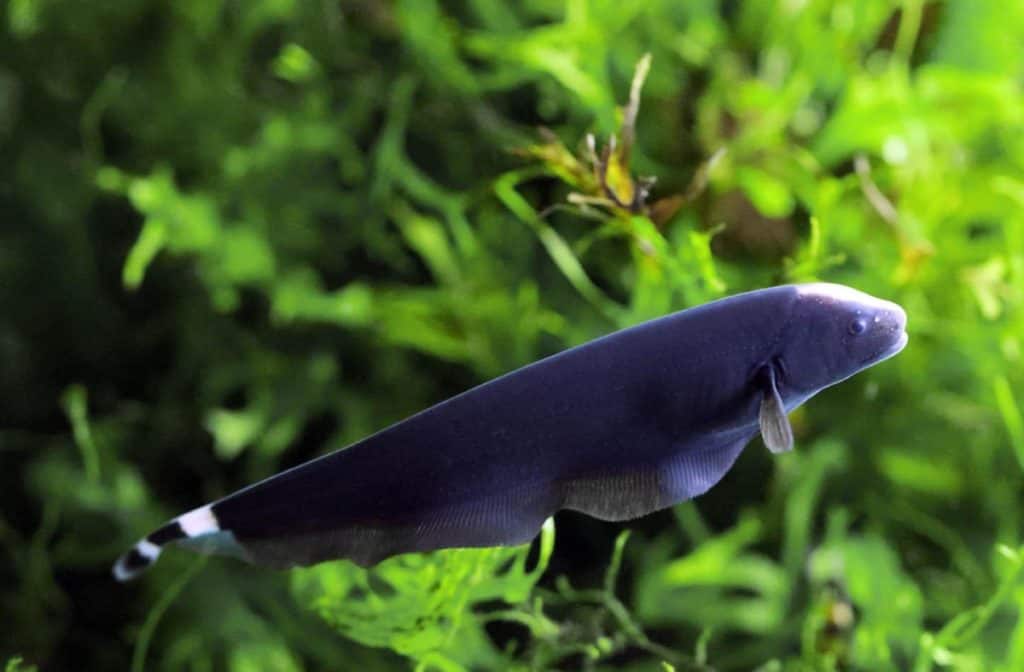
Training Black Ghost Knife Fish
Training a Black Ghost to interact with you and feed from your hand should not be attempted until they are well settled in your aquarium. It takes Black Ghosts time to accustom themselves to a new environment. You should allow them this time, and ensure they are feeding well before you begin training.
There are three steps to follow when trying to get your Black Ghost out in the open through the day and interacting with you. These are:
- Correctly designing their environment
- Conditioning their behavior
- Earning their trust
Steps two and three are pretty much intrinsically linked and should occur in unison. Step one should have already been undertaken before you purchased your Black Ghost. We will cover step one in detail later under 'care'.
Assuming you have the correct environment, you should start coaxing your Black Ghosts to the surface to feed in the evenings. Use live foods to do this that they find tasty as these are most likely to lure them to the top.
Once they are feeding at the surface on a regular basis, you should start offering food from your hand. You can also indicate that you are about to feed them by wiggling your fingers in the surface of the water.
After a while, your Black Ghosts will associate your hand with tasty treats. As a result, they will begin to hang around it when you place it in the water. They will also start to touch you with their tail, rub their abdomens over your hand, and sniff at you.
Fun Fact: Ghost knife fish are one of the smallest species of fish in the world with only ten species in four genera.
Now is the time to start trying to encourage all this behavior through the day in order to get them active.
Please note: You should take care as Black Ghosts are known to nip, and can open their jaws really wide to do this. This will not be a problem when they are of a smaller size as you will barely feel it. However, as they get bigger, any nips will start to really sting.
To discourage this behavior, we recommend that you give them a very gentle flick on their sides which will make them swim away. After a while, they will associate this with the fact they have nipped and should stop doing it.
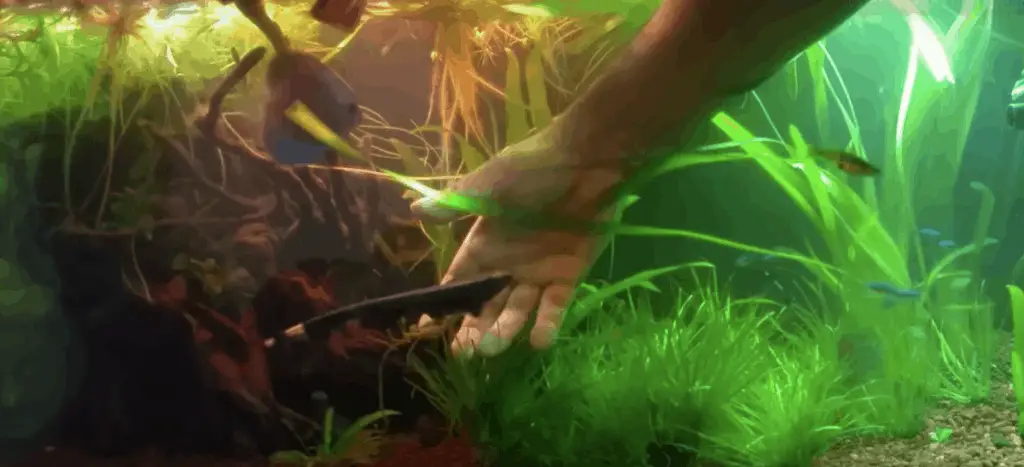
Image Credit Youtube
What do Ghost Knife Fish Eat?
As previously stated, in their natural environment Black Ghost Knife Fish will feed on insects, larvae, small fish, and juvenile larger fish at night. This will not change much in the aquarium. Live foods such as crickets, bloodworm, earthworms, mosquito larvae, and brine shrimp will be their number one choice.
Black Ghosts will also easily feed on most frozen foods such as tubifex, krill, prawn, blood worm, brine shrimp, meats, and calamari. They will not, however, eat dry foods such as flake and pellet very easily.
If you need to feed dry or flake foods you should introduce them to it slowly. Certainly not when you first introduce them to your tank. Black Ghosts may initially struggle to feed in a new aquarium and will need the high nutritional value of foods such as live and frozen.
Feeding once a day is ample for your Black Ghosts. Do this either just before you switch your aquarium lights on, or after you have switched them off. This, of course, does not apply to those Black Ghosts who have been trained to feed through the day.
Here's a complete guide to all the different fish foods available from your local pet store or available to order online.
In their natural environment, Black Ghosts hunt by using their electrosensory and electromotor systems rather than their eyes. This is probably a good thing since, as already briefly mentioned, they have really appalling eyesight. How they do this, work as an electrical fish? Well, it's all really rather clever.
The Electrics
Probably the first thing to clear up is that the Black Ghost Knife Fish is not akin to species such as the Electric Eel which use short, sharp, and powerful shocks (up to 600 volts) to incapacitate their prey.
Rather, Black Ghosts are only weakly electrically charged (less than 1 volt). They certainly don't use their 'charge' to stun prey. On the contrary, Black Ghosts use their electric prowess to navigate, communicate, and hunt.
Located in the Black Ghosts tail is a specialized organ which generates an electric signal into the water. These signals are known as electric organ discharges or EOD's for short. Such signals are picked up by themselves, and other fish in sensory cells located all over their bodies. EOD's are used for two major purposes, electrolocation, and communication.
For electrolocation purposes, the Black Ghost emits a wave of EOD's. This allows them to determine the presence of nearby obstacles and objects by sensing perturbations in the amplitude and timing of the electrical field.
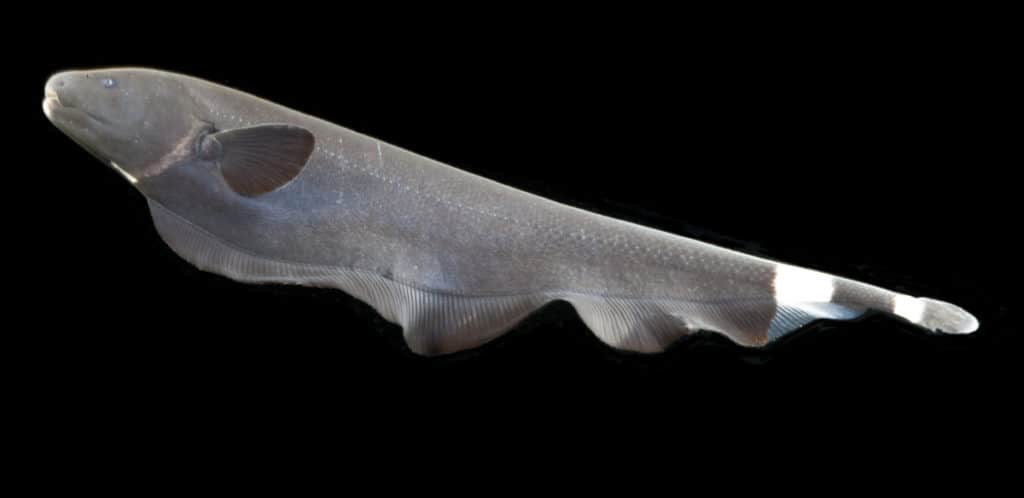
It means that they can then navigate the often dark environment they are swimming in, and successfully find their prey.
For communication, female Black Ghosts have been known to emit their EOD's at a higher frequency to announce that they are female. Submissive males, on the other hand, will omit more frequent EOD's in a show of submission to the dominant males.
Black Ghosts can also block out EOD's from different individuals so that they don't overlap and cause sensory overload.
Caring For A Black Ghost Knife Fish: Prior To Obtaining One
Caring for these magnificent fish starts before you have even purchased one. They require a certain kind of set up to be happy, healthy and thrive. Their aquarium needs to be big enough, have the correct substrate, water parameters, lighting, and contain the appropriate decor.
Aquarium Size
The size of the aquarium you will need for Black Ghosts depends very much on how many you plan on keeping. These are a mighty big fish once fully grown (1' 6") and need a lot of room.
They also do not thrive well, kept together, in aquariums that don't afford them the luxury of (some) solitude. They will fight, possibly to the death, or at the very least be under constant stress.
We highly recommend that you allow 150 gallons for the first of your Black Ghosts, and 100 gallons for each one thereafter. However, since optimum numbers to have for this species are either one or four, it would take an enormous aquarium to keep the latter.
Nonetheless, you may be able to create a good space with a smaller aquarium than recommended. You can try this by providing plenty of the correct decor. Be prepared, however, for this not to work, and have a backup plan in place.
Aquarium Decor suitable for Knife Fish
As the Black Ghost has no scales, they are more prone to injuring themselves on decor and rough substrate. For this reason, sand or fine gravel is a necessity for this species. This is especially true since they spend so much time dwelling at the bottom. Here is where they could scratch, graze, or cut themselves on chunkier substrates.
Black Ghosts are pretty much unbothered by decor as long as there are plenty of places for them to hide.
Hides should be, like substrate, as smooth as possible to ensure they don't get injured. Caves, thick planting, and tunnels are all places they like to retreat to. In fact, this is where they will spend most of their time.
For this reason, as mentioned before, many fish keepers invest in the 'ghost tube' which allows them to view their Black Ghosts through the day.
The Black Ghost itself will be completely oblivious to the fact that the tunnel is see-through due to their poor sight. They, in fact, will feel very safe and secure in these spaces due to their electrical abilities telling them they are encased!
Water Parameters perfect for Black Ghost Knife Fish
As they are a rather messy species, Black Ghosts need excellent filtration. This will ensure that their water parameters stay as near to perfect as possible. The importance of this is due to Black Ghosts being more susceptible to diseases and chemicals in the water (being scaleless) than other fish.
Three-stage filtration would be the recommendation, where it is possible, as this will decrease the chance of disease.
Water parameters should be 73 to 80 °F with a pH of 6.5 to 7, and a KH of 0 to 10. Try to avoid fluctuations of your water parameters if possible, as Black Ghosts will not react well. It's actually better to be slightly off in these parameters and constant, than to try and make them perfect and fluctuate.
Lighting
Being nocturnal, Black Ghosts prefer subdued lighting and will not, without coaxing as previously mentioned, be active in a well-lit aquarium. Should you need stronger lighting in your aquarium for other fish species that you keep, we recommend using floating plants to create shadier areas.
LED lights are perfect as you can control them throughout the day. They are low cost to purchase and run. Here's our guide on the Best LED Aquarium Lights.
Obtaining A Black Ghost Knife Fish And Tank Mates
Before you purchase a Black Ghost it is prudent to check that they will be kept with species that are suitable as tank mates.
Larger fish such as Angelfish, Discus, Catfish, and peaceful Cichlids would be perfect. However, you will need to take care, even with larger fish. More aggressive species such as Rainbow and Red-Tailed Sharks kept with Black Ghosts will not fair well.
You should also avoid smaller fish, crustaceans, and gastropods as your Black Ghost will see these as food. This means avoiding any species of a similar size to the Guppy or Tetra.
You could, however, keep a large group of Corydoras as the Black Ghost should not be bothered by them. Corydoras will also act as an excellent clean-up crew which the heavy waste-producing Black Ghost will need.
When purchasing a specimen, it is worth remembering that both wild-caught and captive-bred are readily available for purchase. However, wild-caught will need a period of quarantine to ensure they are not carrying disease.
A fairly accurate way to know if you are buying wild-caught or captive is to take into consideration the Black Ghost's size. Wild-caught, they are often nearing or over 5 inches in size, whilst captive are usually only around 2 inches.
Caring For Your Black Ghost Knife Fish Once In The Aquarium
Once in the aquarium, you will need to ensure that your Black Ghosts receive regular maintenance. Weekly 20 to 30% water changes with aquarium cleaning should suffice.
Be aware that Black Ghosts are more susceptible to diseases and chemicals in the water since they have no scales. It's important that you do not skip on water maintenance.
On the plus side, being scaleless means that the Black Ghost will exhibit early warning signs of any disease they may pick up. They are prone to skin flukes such as Ich which once caught they will alert you to by rubbing themselves around their aquarium.
Learn how to treat all tropical fish diseases here in one of our recent articles.
They will, however, recover quickly as long as you slightly raise the aquarium temperature. You should never use copper-based medications with this fish.
Breeding Black Ghost Knife Fish
Unfortunately, very little is known about the breeding habits of the Black Ghost Knife Fish. This is because most are bred in large ponds in Indonesia rather than home aquariums.
As previously stated, these are a large species and to create a good breeding environment, unless you have a dedicated tank, will prove to be quite difficult. Black Ghosts also do not have any strong dimorphism, meaning that ensuring you have both males and females is virtually impossible.
Should you still wish to try breeding, however, there are some things you can do to increase the chances of your Black Ghosts mating. These are:
- Keep your aquarium dark and away from the noise and excessive movement.
- Keeping the water around 27 ℃ – this is the optimum breeding temperature.
- Perform 50% water changes every couple of days as this will fool your Black Ghosts into thinking that it is the wet season, ie, time to breed.
Should your Black Ghosts lay eggs you will need to have lots of pebbles and plants in place for the eggs to nestle amongst. This is due to this species having absolutely no attachment to their young. They will eat the resulting eggs and fry as they hatch, if given the opportunity, meaning separation after laying is the best action to take.
The eggs of the Black Ghost are yellow and around 2 millimeters in diameter. They will hatch approximately three days after laying. Fry will require a diet of infusoria, baby brine shrimp, and powdered flake food.
Conclusion: Black Ghost Knife Fish
Overall, the Black Ghost Knife Fish is probably more suited to the moderately experienced fishkeeper than the beginner. This is mainly due to their need for larger aquariums and difficulty in keeping when in groups.
However, should you have a large enough tank and stick to keeping just the one, even the less experienced should find this species fairly easy to handle.
These amazing tropical fish will keep you entertained for years. I have owned several over the past 30 years and the biggest was 8″
For more information, you can check out this ERSS DATA SHEET on the Black Ghost Knife Fish
F.A.Q
- What's the lifespan of a Black Ghost Knife Fish? The average lifespan is 10 years however we have known some live up to 14-16 Years in captivity.
- How big can knife fish grow? In the wild they have been reported to grow up to 20″ ( 50cm ) but in captivity, this is lower 16″ ( 40 cm )max
- How fast do Black Ghost Knife Fish Grow? These fish are not very fast growers. You can expect them to grow around 4-5″ every year for the first 5 years then they will slow down even more.
- Can Black Ghost Knife Fish See? Yes, However, their eyesight is very poor as they are nocturnal fish which means they don't really use their eyes very much and reply on EOD.
- How often do Ghost Fish eat? Once or twice a day is sufficient for Black Ghost Knife fish. They are picky eaters and often refuse to eat dried flake food.
- Are Black Ghost Knife Fish suitable for a community aquarium? We wouldn't recommend it as they grow too big for most home aquariums and will nip the fins of smaller fish.
- What do Ghost Knife Fish Eat? They prefer mostly live foods. However, they will eat freeze-dried krill, bloodworms, brine shrimp and pellets.
Related Posts
- Amazing Tropical fish
- Most expensive fish ever!
- Best fish for beginners
- How long should you leave your lights on for?
- Author
- Recent Posts
![]()
I have been working in the tropical fish industry for over 30 years now and I'm still learning. Everyday is a school day in this hobby. In my spare time I play golf very badly!
![]()
How Big Can a Black Ghost Knife Fish Get
Source: https://fishkeepingforever.com/black-ghost-knife-fish-2/